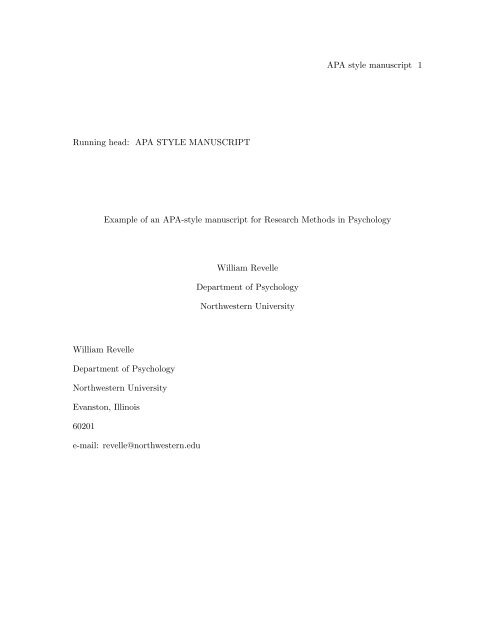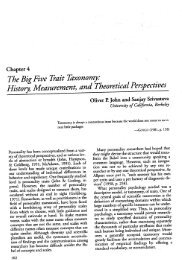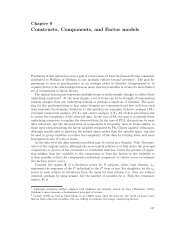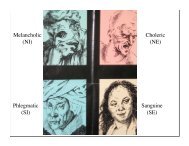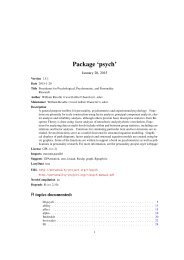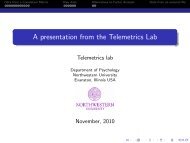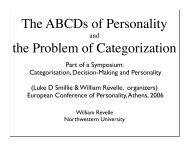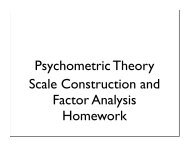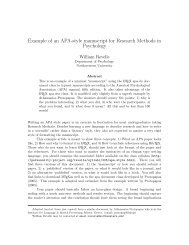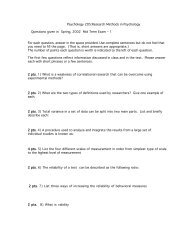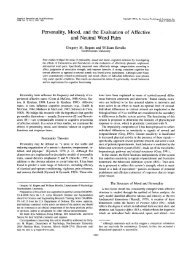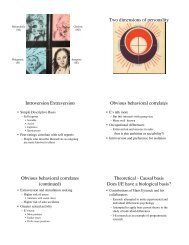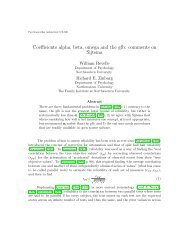man - The Personality Project
man - The Personality Project
man - The Personality Project
Create successful ePaper yourself
Turn your PDF publications into a flip-book with our unique Google optimized e-Paper software.
APA style <strong>man</strong>uscript 1Running head: APA STYLE MANUSCRIPTExample of an APA-style <strong>man</strong>uscript for Research Methods in PsychologyWilliam RevelleDepartment of PsychologyNorthwestern UniversityWilliam RevelleDepartment of PsychologyNorthwestern UniversityEvanston, Illinois60201e-mail: revelle@northwestern.edu
APA style <strong>man</strong>uscript 2AbstractThis is an example of a minimal “<strong>man</strong>uscript” using the L A TEX apa.cls document class totypeset <strong>man</strong>uscripts according to the Americal Psychological Association (APA) <strong>man</strong>ual,fifth edition. It also takes advantage of the L A TEX apa.cite class. It is modified onlyslightly from a superb example by Athanassios Protopapas (2007). <strong>The</strong> abstract shouldconvey five points: 1) why is the problem interesting, 2) what you did, 3) who were theparticipants, 4) what you found, and 5) what does it mean? All this and be less than 100words!
APA style <strong>man</strong>uscript 3Example of an APA-style <strong>man</strong>uscript for Research Methodsin PsychologyWriting an APA style paper is an exercise in frustration for most undergraduatestaking Research Methods. Besides learning a new language to describe research and howto write in a ‘scientific’ rather than a ‘literary’ style, they also are expected to master avery rigid style of formatting the <strong>man</strong>uscript.This example article is meant to show three concepts: 1) What an APA paper lookslike, 2) How and why to format it in L A TEX, and 3) How to include references usingBibTEX. Those who do not want to learn L A TEX, should just look at the format of thepaper and the references. For those who want to master the intricacies of an elegant typesetting language, you should examine the associated folder available on the class syllabus(http://personality-project.org/revelle/syllabi/205/apa.style.html). <strong>The</strong>reyou will find three versions of this document: 1) the ‘<strong>man</strong>uscript’ or how you shouldsubmit a paper, 2) a ‘published’ version of the paper, or what it would look like in ajournal, and 3) an alternative ‘published’ version, or what it would look like in a book.You will also find links to download L A TEXas well as to the apa document class developedby Protopapas (2005). This example is adapted and extended from the example writtenby Protopapas (2005).Your paper should basically follow an hour-glass design. A broad beginning andending with a much narrower methods and results section. <strong>The</strong> beginning should capturethe reader’s attention and the conclusion should leave them seeing the broad implicationsof your study.Following the hour glass metaphor, your first few paragraphs should be broadenough that someone who knows nothing about the problem will become interested andwant to learn more. <strong>The</strong>se first two paragraphs are vital, for if the reader looks at the<strong>man</strong>d is not excited, the rest of the paper will not be read. <strong>The</strong> next few paragraphs are
APA style <strong>man</strong>uscript 4aimed at the reader who already knows something about the research area and wants toknow why this particular paper is worth reading.This first section of the article is typically the introduction and, according to APAstyle, should not bear a section heading. 1 Subsequent sections, however, are titledaccording to the psychological conventions.After several paragraphs of introduction to your research problem, it is useful togive an overview of the specific questions you are addressing.It is very important to compare the ‘<strong>man</strong>uscript’ version of this document with thefinal ‘journal’ view. Using L A TEXwe can go back and forth between these two formats withease. Tables and Figures need to appear at the end of the <strong>man</strong>uscript version, even thoughthey appear embedded in the middle of the printed version.Experiment 1Manuscripts in APA style often contain descriptions of experiments. <strong>The</strong> APA<strong>man</strong>ual specifications for referring to experiments are to use a lowercase “e” whenspeaking generally, as in the previous phrase, but an uppercase “E” when mentioning aparticular experiment (as in the following phrase), such as Experiment 1.Method<strong>The</strong> “method” is a subsection of the experimental presentation in which all thedetails of setting up and conducting the experiment are described. <strong>The</strong>re are a number ofmore or less standard components to a method, shown below. Think of a methods sectionas a recipe. First you talk about the ingredients, then you talk about what you do withthose ingredients.Participants. Psychological experiments are conducted with participants, usuallyhu<strong>man</strong>s. Note that these used to be called “subjects” but apparently APA now finds it
APA style <strong>man</strong>uscript 5inappropriate to refer to people with this term. Here we mention how <strong>man</strong>y participantsthere were, their ages and other information about them. In particular, how <strong>man</strong>y weremale and how <strong>man</strong>y were female. How were they chosen?Apparatus. Sometimes it is necessary to give the apparatus a special section. Thissection can also be called ‘Materials’.<strong>The</strong> distinction between materials/apparatus and procedure may be thought of interms of having two research assistants. One gets the materials ready, the second runs theparticipants. Everything that assistant 1 needs to get ready should be inmaterials/apparatus, everything that assistant 2 needs to do is in procedure. <strong>The</strong>re shouldbe no surprises! Assistant 2 should not be told to create a new questionnaire, this shouldhave been done by Assistant 1. Apparatus or Materials are the ingredients that will beused.Stimuli. What the subjects saw, heard, or felt. Usually stimuli are part of thematerials or apparatus, but if doing a psychophysics study, it is important to describe howthe stimuli were generated and include such detail as screen decay rate and visual angle.Procedure. What was done to the subjects. This should be detailed enough thatsomeone else could run the study following the procedures section. If you had specialinstructions or were following a script, include the script.ResultsIn this subsection, one shows numbers and statistical analyses. Seasoned researchersoften avoid reading the results section in the first reading, especially if the article is not ofparticular interest for their own research.Results should be stated first in words, then numbers, and then statistics. E.g.,participants in the relaxed condition (M= 5.1, sd = 1.66) did better than those in the
APA style <strong>man</strong>uscript 6stressed condition (M=2.8, sd = 1.93), t(38) = 2.85, p < .05, p-rep = .96.Note that the use of the p-rep (probability of a replication) statistic (Killeen, 2005)is now required by articles submitted to Psychological Science (but not to an APAjournal). This reflects a general appreciation that what is important is not rejection of thehypothesis that groups do not differ but rather an estimate of the particular parameter ofinterest. (We do not say that the speed of light is not zero, we care about what it is, andwith what error of estimate.) <strong>The</strong> p-rep statistic is a beginning of this movement, for itforces us to think about the probability of getting a result in the same direction if we dothe study again. P-rep may be calculated using the p.rep function in the psych package(Revelle, 2012) in R (R Development Core Team, 2012).We can also include a figure to show results graphically (Figure 1). Without usingL A TEXjust include the figure(s) as the last page(s) of the <strong>man</strong>uscript. However, if you wantto try L A TEX, there are two ways of doing this: use the normal includegraphicscom<strong>man</strong>d, or use the fitfigure com<strong>man</strong>d that comes with apa.cls. <strong>The</strong> later techniquescales the figure to fit one or two columns.DiscussionIf the results of the experiment mean anything, this is the place to talk about it. Ifthis is a two study paper, then this discussion is just about Experiment 1. No newnumbers should appear in the discussion section. If you want to introduce a number, do itin the results section.Experiment 2Usually one experiment is not enough to convince anyone; you need additionalcontrol experiments to make your point. Indeed, some articles will include <strong>man</strong>y differentexperiments. <strong>The</strong> introduction to experiment 2 could discuss what is missing fromexperiment 1 and how experiment 2 addresses the problem. For class projects, typically
APA style <strong>man</strong>uscript 7one experiment is enough. However, for publications in some journals (e.g., Journal of<strong>Personality</strong> and Social Psychology it is typical to have multiple experiments.Method<strong>The</strong> method can be the same as for the previous experiment, since here we aresimply interested in showing the structure of the <strong>man</strong>uscript. If the methods do differfrom Study 1 to Study 2, highlight how they differ.ResultsThis is a good point to show an example of a table following APA conventions. Notethat we don’t use any vertical separators and that columns can be grouped with partialhorizontal lines. Also keep in mind that the caption must precede the table. <strong>The</strong> label isentirely optional, but useful for referring to the table in the text, for example this onewould be Table 1. One of the trickiest problems in L A TEXis getting the figure or table toappear roughly where you want it. This is not a problem in the ‘<strong>man</strong>uscript’ version, forall tables and all figures are put at the end. But if you are doing ‘jou’ or ‘doc’ formatting,the tables will appear at places that a not very clever typesetter would put them, butprobably not where you would put them.DiscussionThis is a discussion just of the second study.General Discussion<strong>The</strong> first paragraph of the general discussion is sometimes referred to as the “wakeup grandma” paragraph. That is, the reader who has almost fallen asleep reading yourmethods and results needs to be reminded why this research is exciting and important.<strong>The</strong> three most important paragraphs in the entire article are the abstract (which readers
APA style <strong>man</strong>uscript 8will find by literature searches), the opening paragraph of the introduction and the theopening paragraph of the discussion. <strong>The</strong>se last two paragraphs need to make the readerwant to read the article, and then remind the reader how exciting the article really is.In psychological articles there is usually some point to the whole experimentalexercise, and in the end we get to discuss how important it all is. Although literature issupposed to have been covered in the introduction, for this example we can illustrate theuse of bibliographic citations in this final section. <strong>The</strong> accompanying package “apacite” byErik Meijer provides everything an APA-style writer needs for citations, such as in-textcitations in which one can claim that Leary (2007) mentioned or failed to mentionsomething.It is important to note that books (Leary, 2007) are cited in the bibliographydifferently than chapters (Revelle, 2007) or articles (Killeen, 2005). <strong>The</strong> specific rules forcitations are complicated, but actually are included in such bibliographic tools as the opensource format BibTex (which can be used by L A TEXusing the apa.cite com<strong>man</strong>ds) or thecommercial program EndNote. For Northwestern students, EndNote may be downloadedfor personal use. <strong>The</strong> official guide to how to include references is the APA style <strong>man</strong>ual(Association., 2010), but “cheat sheets” may be found on the web by searching for ‘APAstyle’. Although the APA.cls includes formatting in APA style, <strong>man</strong>y of us prefer to usethe natbib package.Some important rules for those who choose not to use L A TEX. <strong>The</strong> <strong>man</strong>uscript needsto be double spaced throughout, with ragged right margins. Tables appear on separatepages following the References. <strong>The</strong>n comes a page of Figure Captions, then come thefigures. Examine the ‘<strong>man</strong>uscript’ example on the web page very carefully.
APA style <strong>man</strong>uscript 9ReferencesAssociation., A. P. (2010). Publication <strong>man</strong>ual of the american psychological association(6th ed.). Washington, DC: American Psychological Association.Killeen, P. (2005). An alternative to null-hypothesis significance tests. PsychologicalScience, 16 , 345-353.Leary, M. R. (2007). Introduction to behavioral research methods (5th ed.). NeedhamHeights, Ma.: Allyn and Bacon.Protopapas, A. (2005). Example of an apa-style maunscript: a guide to using apa.cls.Retrieved August 20, 2007, fromhttp://www.ilsp.gr/homepages/protopapas/apacls.html.Protopapas, A. (2007). apa.cls: A genuine LATEX solution for psychological researcharticles. Eutypon.. Retrieved fromhttp://users.uoa.gr/\~aprotopapas/CV/pdf/Protopapas 2007 Eutypon.pdfR Development Core Team. (2012). R: A language and environment for statisticalcomputing [Computer software <strong>man</strong>ual]. Vienna, Austria. Retrieved fromhttp://www.R-project.org/ (ISBN 3-900051-07-0)Revelle, W. (2007). Experimental approaches to the study of personality. In R. Robins,R. C. Fraley, & R. F. Krueger (Eds.), Handbook of research methods in personalitypsychology. (p. 37-61). New York: Guilford.Revelle, W. (2012). psych: Procedures for personality and psychological research[Computer software <strong>man</strong>ual]. Evanston. Retrieved fromhttp://personality-project.org/r (R package version 1.2.8)
APA style <strong>man</strong>uscript 10Author NoteAdapted (and at times just copied) from a similar document by AthanassiosProtopapas who is at the Institute for Language & Speech Processing Athens, Greece.(email: protopap@ilsp.gr). <strong>The</strong> L A TEXform of this <strong>man</strong>uscript has comments pointing outwhat is mainly by AP and what additions were done by WR.William Revelle may be contacted at email:revelle@northwestern.edu)
APA style <strong>man</strong>uscript 11Footnotes1 That is, there is no “Introduction” section.
Figure CaptionsAPA style <strong>man</strong>uscript 13
Notched boxplots of N(0,1) for n=25-2 -1 0 1 2 3 41 2 3 4 5 6 7 8 9 11 13 15 17 19


